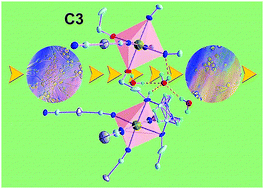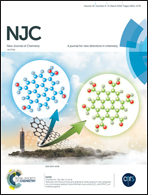In vitro biological properties and predicted DNA–BSA interaction of three new dicyanidoargentate(i)-based complexes: synthesis and characterization†
Abstract
The reaction of certain metal salts with N,N′-bis(2-hydroxyethyl)ethylenediamine (bishydeten) and [Ag(CN)2]− resulted in [Ni(bishydeten)2][Ag(CN)2]2·H2O (C1), [Cu(bishydeten)2Ag2(CN)4] (C2) and [Cd(bishydeten)0.5]2[Ag(CN)2]4·3H2O (C3), characterized by elemental, magnetic (C1 and C2), FT-IR, EPR (C2), ESI-MS, thermal, spectroscopic (C1, C2 or C3), and X-ray diffraction (C3) techniques. A detailed study of the antiproliferative and apoptotic properties of all the compounds and [Ag(CN)2]− was carried out using the BrdU Cell Proliferation Assay (BCPA), DNA laddering assay and TUNEL method on HT29, HeLa, C6, and Vero cell lines. These compounds exhibiting a very strong antiproliferative effect even at low micromolar concentrations were found to have cytostatic activity, whereas [Ag(CN)2]− had cytotoxic activity. The cells exposed to the compounds showed DNA laddering formations and the appearance of apoptotic bodies. Also, application of the test compounds at low concentrations was associated with a pronounced loss of the adhesive, migratory, and topoisomerase I activity of the treated tumor cell lines. Immunohistochemical staining analysis demonstrated that these complexes significantly reduced the level of Bcl-2 while causing the accumulation of P53 in HeLa and HT29 cells. Absorbance and emission spectral data reveal that the complexes interact with the DNA via a groove binding mode of interaction.



 Please wait while we load your content...
Please wait while we load your content...